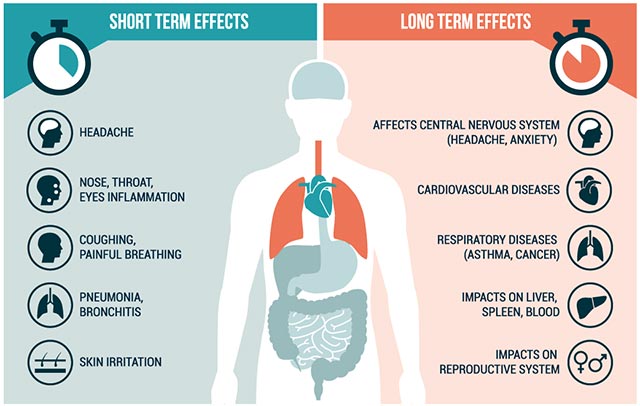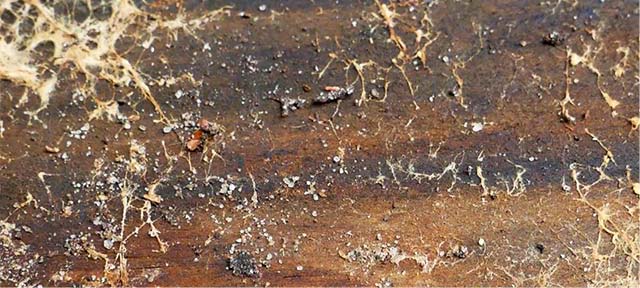
Breathe Easy
What is the best kind of RV? The kind that doesn’t smell like one. Never discount the importance of good air quality.
Indoor Pollutants Can Affect Your Health
Volatile Organic Compounds, often called VOCs, are gases emitted from certain substances or products that could be in a liquid or solid form. These and other pollutants can be 5-10 times greater indoors than those outdoors, largely because they are contained. But when the construction materials of your RV or another structure actually aid in the production of pollutants over time, the dangers can be far greater. Mold, mildew, and toxic chemicals, including formaldehyde, are examples of pollutants that accumulate in confined spaces with temperature fluctuations when moisture is present.
Formaldehyde is among the dangers present in RV’s and other structures made with plywood. It is a colorless gas, but certainly not odorless. It has a strong, putrid odor that, once you’ve smelled it, you won’t soon forget.
Formaldehyde has been classified as a carcinogen by the World Health Organization (WHO) and International Agency for Research and Cancer (IARC). By definition, a carcinogen is a substance that is capable of causing cancer.


More About Formaldehyde
Trace amounts of formaldehyde are common in nature and some everyday products. It’s more abundant in laminated products when used in the resin. Though better regulated than in the past, imported plywood can still be made with formaldehyde based adhesives – specifically urea formaldehyde. Decomposition of adhesives can occur when wood is exposed to water and temperature variations. As adhesives break down, elevated temperatures release the formaldehyde from the adhesive, a process known as hydrolose. When this occurs, the contamination of the air your family could be breathing is further compounded by the likelihood of mold or mildew growing on the wet wood.
When renovating an RV, or working to remove water damage and mold, take proper precautions and wear protective gear, including gloves and a respirator mask. In a video on our Testimonials page, a couple removed plywood that was stamped with a formaldehyde warning. Wood sheets used in today’s traditional construction still have these warnings. Demand better from your RV makers!
Did We Mention Mold?
Mold can cause allergic reactions in asthmatics. But anyone, with or without allergies, may experience irritation of the eyes, skin, nose, throat and lungs when exposed to airborne mold particles. Chronic Obstructive Pulmonary Disease, or COPD, is a common lung disease that includes bronchitis and emphysema, and the fourth leading cause of death in the United States. Avoiding pollutants, including smoking, chemicals, mold, dust, and fumes are recommended by the American Lung Association to avoid exacerbation of symptoms.
Learn more about mold and the mold testing we’ve had performed.


What Else?
RV’s and other structures that are not lived in year-round are often closed for weeks or months without ventilation. After leaks have occurred and mold growth and adhesive decomposition have begun, those units are particularly susceptible to more serious conditions with pollutants that can become airborne. Some of the common hazards are shown here, with those in red being particularly relevant in structures made with plywood and susceptible to water damage.
Smoke detectors help to protect people from smoke and fire. There are carbon monoxide detectors to protect us from the deadly odorless gas that we can’t see, and propane detectors to identify leaks that can put your family members at risk. These are common standards or options in most RV’s manufactured today. But how does one protect his or her family from volatile organic compounds and pollutants?
Read on to learn how to avoid these problems.
What can you do to protect your family from harmful pollutants?
Using a water-resistant composite material is one way to avoid all of the above problems, and is a common sense move that many manufacturers in the RV industry are already making. Families are demanding healthier alternatives in RV construction, and the industry is taking notice. Azdel Onboard composite sheets are a proven solution for these and other major issues that plague manufacturers and RV owners alike. There is no natural fiber decomposition, so the composite does not warp or rot and does not grow mold or mildew. Equally important, it does not release toxic chemicals into the air that you and your family breathe.
Considering an RV purchase? Learn more about which manufacturers use Azdel Onboard composite panels in their wall, ceiling and roof construction.
Download a PDF that lists RV manufacturers currently using Azdel composite panels, and visit manufacturers’ websites to find a dealership near you.
Ask your dealer representative which units have Azdel and look for our logo.
